In the early 1980s, Lee Iacocca, the head honcho of Chrysler, starred in a famous TV commercial where he brazenly proclaimed, “If you can find a better car, buy it.” This quip underscored his confidence in the automaker’s new lineup of economical, front-wheel-drive vehicles, a product line that ended up saving the Pentastar brand from collapse. Spending a week in the 2022 Polestar 2 had me ruminating on Iacocca’s famous dictum because this stylish EV is based on several Volvo models, sharing loads of components with the XC40 range and the C40 Recharge. Yet in some important ways, this Polestar drives better and feels nicer than the cars it’s based on. So, I guess if you can find a better Volvo, buy a Polestar.
What is the Polestar 2?
Despite being stylish and sporty, the Polestar 2 is difficult to classify. The automaker simply calls it a fastback, which means you’re free to choose your own adventure. This vehicle could be considered a crossover, a four-door coupe or maybe even a sedan. All those formfactors fit the bill in one way or another, though ultimately it doesn’t matter how you classify the Polestar 2 because it’s simply excellent.
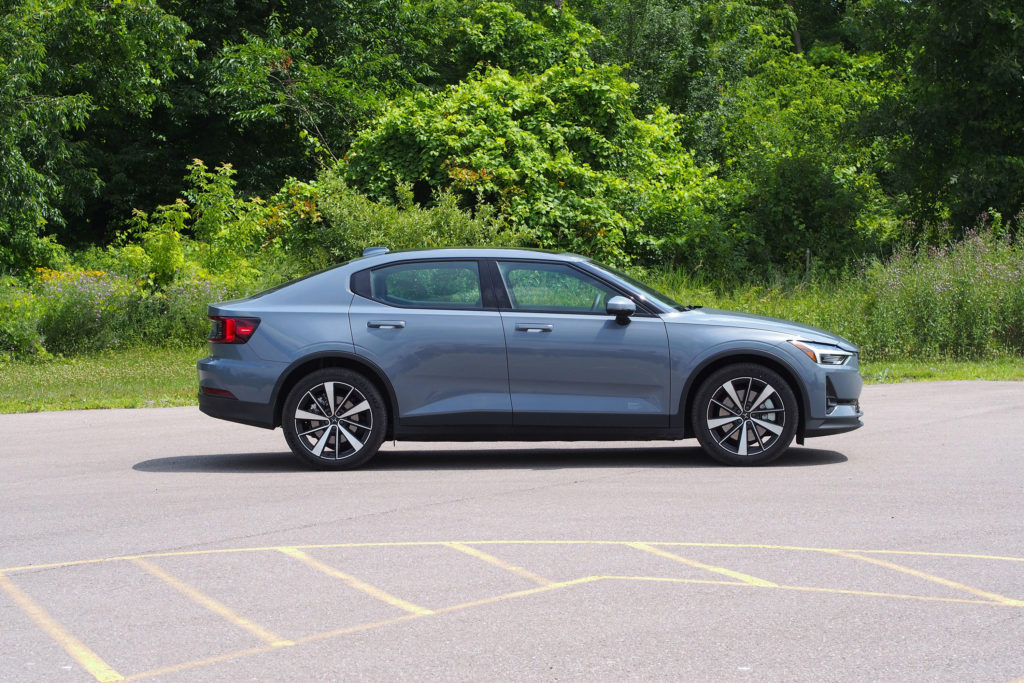
Broadly speaking, this vehicle is offered in two flavors: Single Motor, which is what’s being evaluated here, and Dual Motor. The former is front-wheel drive and the latter has — you guessed it — four driven wheels. Not surprisingly, there are some significant performance differences between those two models.
Facts and figures
The Single Motor version of the Polestar 2 has 231 horsepower, while the Dual Motor features 408. For added oomph, Dual Motor models can be fitted with an optional Performance Package that boosts output to 476 hp. Torque clocks in at 243, 487 and 502 pound-feet, respectively. The Single Motor model can hit 60 miles per hour in an entirely competent 7 seconds, though the Dual Motor is way quicker, able to do the same in about 4.5. The Performance Package shaves an additional 0.3 seconds off that time, making a legitimately quick sprint even more impressive.
WOW, JUST WOW: 2022 Hyundai Ioniq 5 review: One of the best
When it comes to range, Single Motor versions can go an EPA-estimated 270 miles between charges, a good showing, even if it’s a bit short of the 300-mile mark we like to see at EV Pulse. The Dual Motor model is rated at a less impressive 249 miles for 2022, though that has increased to 260 for 2023, ditto for models fitted with the Performance Package.
Regardless of which Polestar 2 variant you opt for, all of them feature a 78-kWh battery. If you care about nitty-gritty details, that pack has 75 kWh of usable capacity.
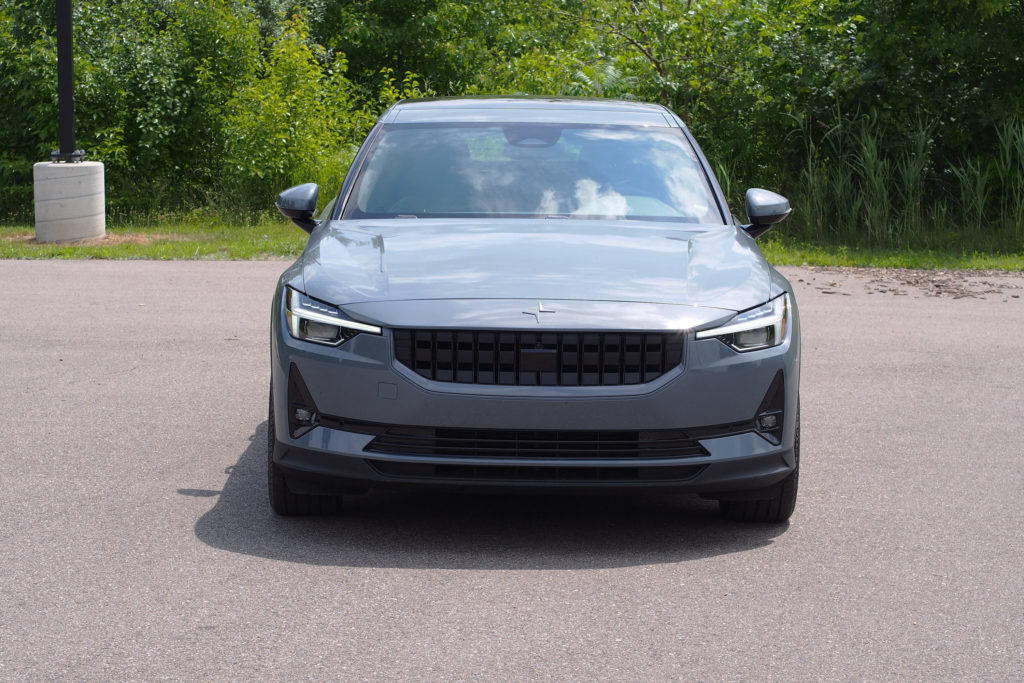
As for DC fast charging rates, the Polestar 2 initially topped out at 150 kW, but a software update increased that to a respectable 155. Hooked to a DC fast charger, this vehicle should be able to go from a 10% state of charge to 80% in an entirely competent 33 minutes.
Naturally, Level 2 AC charging — like you’d do at home — is much slower, though it’s no worse than any other modern EV. Expect zero to full in around 8 hours.
A wow-worthy interior that’s eco-friendly, too
Moving inside, the Polestar 2’s cabin is as beautiful as it is eco-conscious. If you eschew the available Napa leather, this interior it totally vegan, containing no animal products whatsoever, no down-stuffed seats, no ivory-trimmed switches and no floor mats made from the pelts of baby Siberian tigers.
That emphasis on sustainability makes it sound like things might feel a little cheap, but that is not the case. The soft plastics look great and feel just as good, and models fitted with the available Plus Package also feature responsibly harvested ash wood accents treated to a lovely open-pore finish. That options group also includes WeaveTech, a lovely wetsuit-like fabric that’s made from recycled fibers and is more durable, easier to clean and lighter than traditional leather. Cows everywhere are sure to appreciate this news. Going forward, Polestar is also working on new materials made from recycled plastic bottles and even an ersatz carbon fiber containing flax.
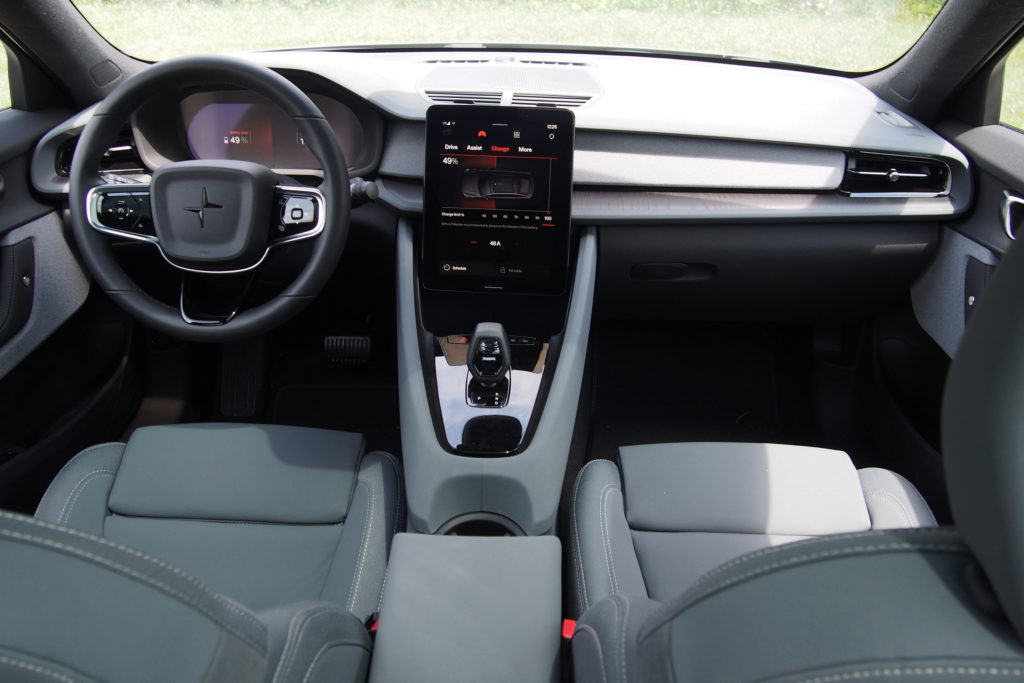
Aside from interesting and ecological materials, there’s plenty more to like about this interior, though a couple things could be improved. Spend a minute looking around and the Volvo influence becomes obvious. The control stalks, steering wheel buttons, shifter and door handles are all pretty much copied and pasted, though this is not a bad thing, in fact, it’s a wonderful place to start.
CHECK THIS OUT: 2023 Nissan Ariya first drive review: Worth the wait
In-cabin tech is another huge advantage of this design-focused EV. In front of the driver is a 12.3-inch digital instrument cluster, which is par for the course these days. But the real star is the lovely 11-inch portrait-oriented touch screen that’s home to an Android-based infotainment system.
Polestar’s multimedia array is fairly new, but it’s already one of the best in the business. This system is as intuitive as they come, it’s immediately responsive and it comes with a whole bunch of Google services including Google Assistant, the Google Play Store and Google Maps. That last item is arguably this infotainment system’s signature feature because it’s blazing fast, super easy to figure out and always up to date.
The Polestar 2’s back seat is mostly comfortable, even if it still has a big, ol’ hump in the middle instead of a flat floor like you get in many modern EVs. There’s plenty of legroom and a good amount of noggin space too, though the rear doors are small and a bit difficult to get through if you’re any less spry than an 8-year-old.
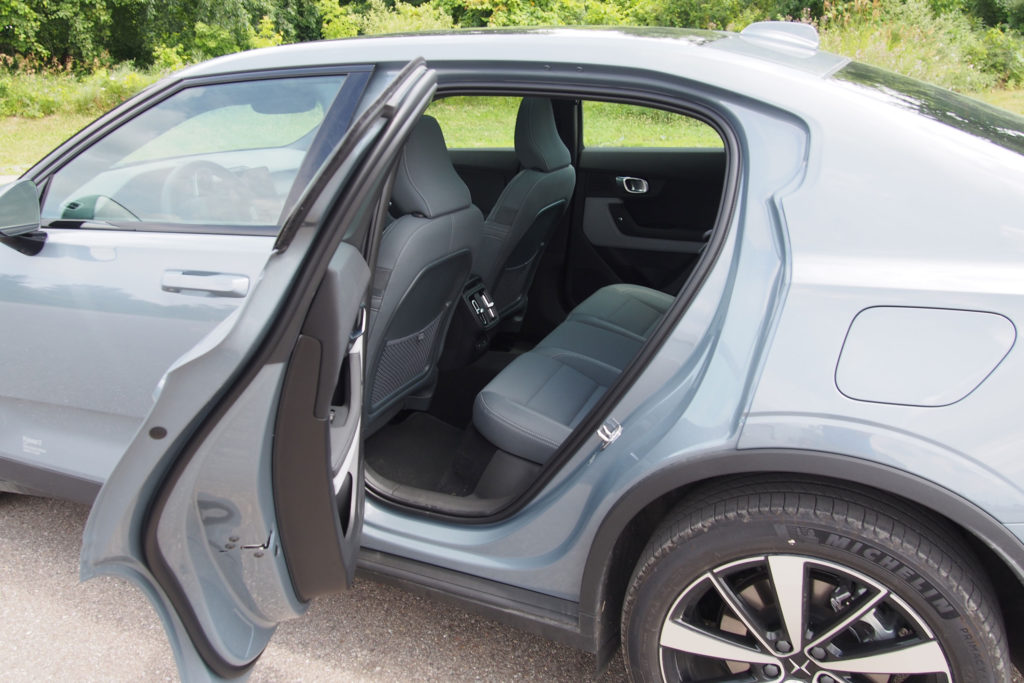
The Polestar 2 evaluated in this review is fitted with two options groups, the Plus Package and the Pilot Package. The former adds amenities like a range-improving heat pump to the HVAC system, power front seats, a wireless charging pad, a panoramic glass roof and a premium Harman Kardon sound system. As for the must-have Pilot Package, it includes a 360-degree camera system that’s one of the sharpest in the business, an excellent adaptive cruise control system with lane centering, rear cross-traffic alert with automatic braking and blind spot monitoring with steering assist.
Given its rather rakish roofline, the Polestar 2 isn’t the most versatile vehicle around, but it’s still a capable schlepper. Under the hood is a small, 1.2-cubic-foot front trunk that’s large enough to store the portable charger and not much else. Including the underfloor cubby, you get 14.3 cubes behind the rear seat and up to 38.7 cubic feet when this EV is loaded to the roof.
But are there any downsides to the Polestar 2’s interior? Truthfully, only a handful of things. First, the gargantuan center console feels like a waste of space as it’s super high and doesn’t really allow you to store mush stuff. Next, the sun visors do not extend, so taller folks have to live with blinding glare from the side windows. And finally, somebody totally forgot about the center air vents. They’re in a poor location and look like a complete afterthought.
Agile and refined manners
The first things you’ll notice about driving the Polestar 2 is how well it rides and the quietness of the interior. Dual Motor models, which this example is not, can be had with adjustable Öhlins dampers as part of the optional Performance Package. But even without that add-on, the ride here is firm, which controls the body well, but it’s never harsh or abrasive. Some EVs bob around like an inflatable dinghy caught in a nor’easter, but this vehicle always feels planted. Interior noise levels are also extremely low.
Acceleration is silky smooth, just not ferocious. The Single Motor Polestar 2 is plenty quick, though it is not a high-performance automobile, especially off the line. Initial accelerator tip-in is soft, almost lethargic, like you have to go three-quarters of the way to the floor just to get moving, but past about 10 MPH everything feels perfectly normal. Talk about weird tuning.
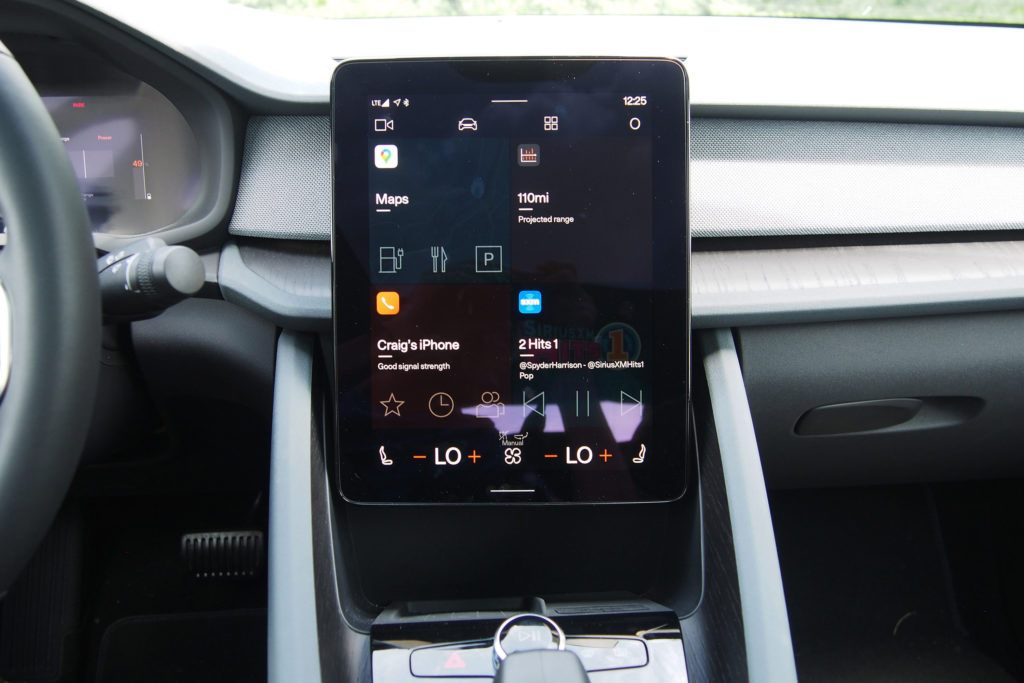
The Polestar 2’s steering is free of harshness or kickback, though it also manages to feel livelier than what you get in many EVs these days, so hooray for that. You can also adjust the tiller’s firmness as well as how aggressive the regenerative braking is. These are a snap to tweak via the infotainment screen. Keeping things refreshingly simple, you don’t have to dig through 10 menus to get at this stuff, which is a very good thing, especially while underway.
SEE ALSO: Electrified Chevy Corvette E-Ray accidentally makes an early appearance online
On the road, some of those advanced driver aids mentioned earlier should probably be standard. It’s only available in the Pilot Package, but the blind spot monitoring with steering assist feels particularly necessary. The Polestar 2’s rearmost roof pillars are chunky and do a great job blocking visibility.
A stylish, refined and desirable EV
The Polestar 2 is an unexpectedly compelling EV that drives well and looks great. The stylish and eco-friendly interior is lovely, the infotainment system is one of the best in the business, the vehicle offers luxury-car levels of refinement and the Polestar 2’s bodywork is tasteful yet still eye-catching. As for downsides, there are a few minor complaints. It’s a shame the console isn’t more versatile, the center air vents on the dashboard make no sense, the sun visors really need to extend and finally, from a git, the acceleration is too dull.
Pricing is another thing to like about the 2022 Polestar 2. This Single Motor model checks out for a totally reasonable $55,600. Of course, a few options pad the bottom line. There’s $4,000 for the Plus Package, $3,200 for the Pilot Package and $1,200 for metallic paint.
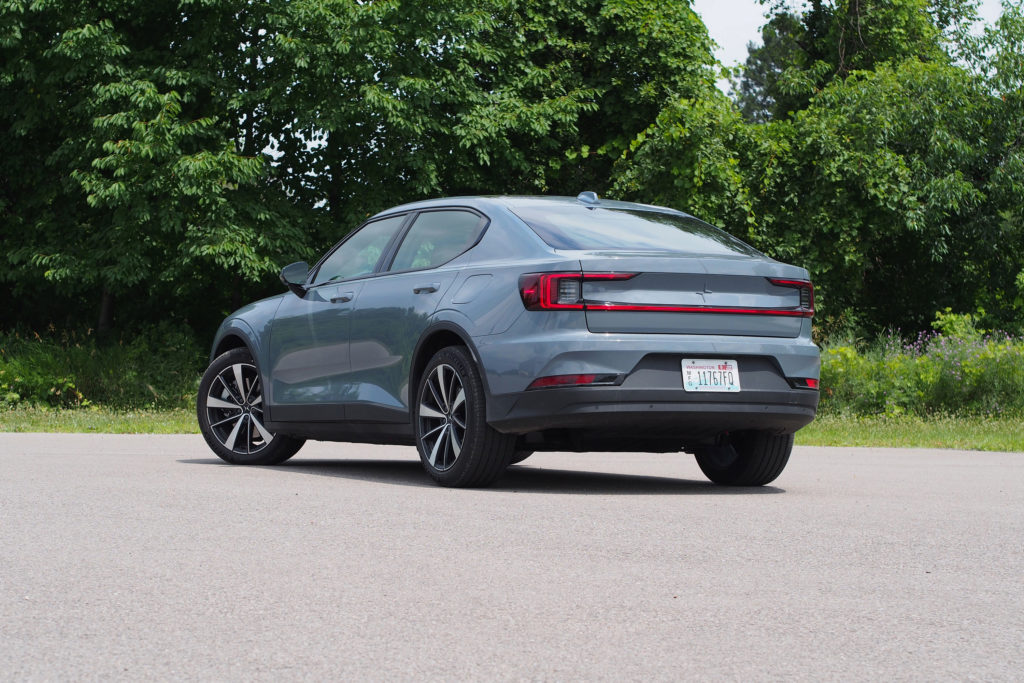
If you can’t get your hands on a 2022, here’s how pricing has changed for 2023, and of course it’s increased, with every options package creeping up slightly. Premium paint colors are a touch more than before and the vehicle’s destination fee has increased by one Benjamin Franklin to $1,400. If you grab a Dual Motor, all-wheel-drive model with every available option you’ll be spending around 70 grand, which is a lot of money, though the Polestar 2 still manages to feel worth it.
At a glance
- Year: 2022
- Make: Polestar
- Model: 2
- Trim: Single Motor
- Type: Electric crossover utility vehicle
- Horsepower: 231
- Torque (pound-feet): 243
- MPG ratings (city/highway/combined): 113/100/107
- Range: 270 miles
- Pros: Sleek styling, beautiful interior, Google-based infotainment system, well-controlled ride
- Cons: Non-extending sun visors, odd air vent placement, soft accelerator pedal responsiveness
- Estimated base price: $47,200
- Estimated price as tested: $55,600
